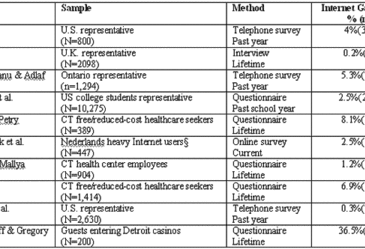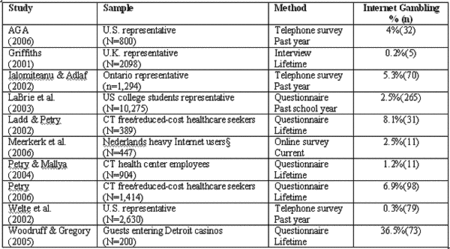In 2006, the United States Senate, under former-majority leader Bill Frist, voted to make Internet gambling illegal by passing the Internet Gambling Enforcement Act (Rose, 2006). Legislation often moves at a faster pace than science. Consequently, bills and laws often reflect public opinion rather than empirical evidence. In the absence of scientific research, the Senate relied largely on anecdotal reports to support the Act. This week’s WAGER will examine the current state of research about Internet gambling and what that research can tell us about the extent and impact of such gambling.
A PsycInfo database search using the terms “Internet” and “gambling” yielded 72 peer reviewed articles, 24 of which specifically address Internet gambling. The others are articles primarily about compulsive Internet use or traditional gambling. Of those 24 articles, only 11 report original research. Since the chief concerns fueling legislation have been concerns about the perceived prevalence of Internet gambling and the extent of problematic Internet gambling, it is important to examine what current research can tell us about these rates.
Of the 11 empirical studies, five contain prevalence estimates for Internet gambling. In addition to these studies, we investigated the published reports from the four US national surveys that measured the prevalence of gambling and gambling-related problems (Gerstein et al., 1999; Kallick, Suits, Dielman, & Hybels, 1979; Petry, Stinson, & Grant, 2005; Welte, Barnes, Wieczorek, Tidwell, & Parker, 2002). The national survey conducted by Welte and colleagues (2002) was the only one which published rates of Internet gambling. Finally, we investigated studies of Internet gambling prevalence mentioned in the articles obtained through our PsycInfo search. This strategy identified four additional studies with prevalence rates for Internet gambling (including one non-peer-reviewed report: the AGA State of the States Survey), bringing the total to ten. Table 1 presents the design and findings of those 10 studies.
Table 1. Internet Gambling Prevalence Rates
§ Used Internet =16h/week and had Internet access at home for =1yr.
These results indicate that in the US general population, the rate of Internet gambling is between 0.3% and 4%. The rate found for college students falls within that range, but the research suggests that internet gambling might be higher among lower income respondents (i.e., reduced-cost health care seekers: 6.9%-8.1%), and higher still among casino gamblers. Only the studies by Petry (2006), Petry & Mallaya (2004), and Ladd & Petry (2002) provided information about gambling problems. Both the Petry (2006) and Ladd & Petry (2003) studies found that people who reported Internet gambling were more likely to have gambling problems than others. The Petry & Mallaya (2004) study found that disordered gamblers were more likely to report Internet gambling than others.
However, these studies are limited in their ability to accurately identify the extent of Internet gambling. Few of the studies used samples representative of the general population. For example, the study by Woodruff & Gregory might have obtained its elevated rate because casino gamblers are more likely to gamble on the Internet, because Detroit residents are more likely to gamble on the Internet, or because people who are willing to fill out a questionnaire when approached are more likely to gamble on the Internet. Additionally, all of the studies rely on self-report. Memory can bias this kind of data because of memory-errors and misinterpretation of questions (Williams & Wood, 2004). Adults might tend to underreport and youth to over report negative behavior. Finally, none of these studies provide information about gambling problems specifically related to Internet gambling.
To move forward, the field of gambling studies needs to conduct rigorous research on the distribution of Internet gambling, the distribution of Internet gambling problems, and the risk factors for those problems. It is time to provide legislators with empirical research using representative samples and real-time observations. Scientifically sound research is necessary to report accurately about the Internet gambling phenomenon, and to provide policy makers with valid information so that they can make informed decisions.
In the 1960’s, many parents stopped their children from placing a record needle onto a group of rock and rollers from Britain for fear of what bad influence this group might have on vulnerable youth. In the new millennium, people still institute rules based on fears and expectations rather than sound knowledge. Science has the potential to correct this longstanding tradition through systematic observation. The extent of Internet gambling and problematic Internet gambling will become evident only through the application of scientific methods. In the short-term, we can hope that legislators will examine a larger body of empirical evidence available about Internet gambling. In the long-run, careful scientific observation can provide a better understanding of Internet gambling and its potential problems.
What do you think? Comments on this article can be addressed to Erinn Walsh.
References
American Gaming Association. (2006). 2006 State of the States: The AGA Survey of Casino Entertainment. Washington D. C.: American Gaming Association.
Gerstein, D., Murphy, S., Toce, M., Hoffmann, J., Palmer, A., Johnson, R., et al. (1999). Gambling impact and behavior study: Report to the National Gambling Impact Study Commission. Chicago: National Opinion Research Center.
Griffiths, M. D. (2001). Internet gambling: Preliminary results of the first U.K. prevalence study. eGambling: The Electronic Journal of Gambling Issues Retrieved June 3, 2004, from http://www.camh.net/egambling/issue5/research/ griffiths_article.html
Ialomiteanu, A., & Adlaf, E., M. (2002). Internet gambling among Ontario Adults. Retrieved June 3, 2004, from http:// www.camh.net/egambling/issue5/research/ialomiteanu_adlaf_article.html
Kallick, M., Suits, D., Dielman, T., & Hybels, J. (1979). A survey of American gambling attitudes and behavior (Research report series, Survey Research Center, Institute for Social Research). Ann Arbor, MI: University of Michigan Press.
Labrie, R. A., Shaffer, H. J., LaPlante, D. A., & Wechsler, H. (2003). Correlates of college student gambling in the United States. Journal of American College Health, 52(2), 53-62.
Ladd, G. T., & Petry, N. M. (2002). Disordered gambling among university-based medical and dental patients: A focus on Internet gambling. Psychology of Addictive Behaviors, 16(1), 76-79.
Meerkerk, G.-J., Van Den Eijnden, R. J. J. M., & Garretsen, H. F. L. (2006). Predicting Compulsive Internet Use: It’s all about sex! Cyberpsychology & Behavior, 9(1), 95-103.
Petry, N. M. (2006). Internet gambling: An emerging concern in family practice medicine? Family Practice, 23(4), 421426.
Petry, N. M., & Mallya, S. (2004). Gambling participation and problems among employees at a university health center. Journal of Gambling Studies, 20(2), 155-170.
Petry, N. M., Stinson, F. S., & Grant, B. F. (2005). Comorbidity of DSM-IV pathological gambling and other psychiatric disorders: Results from the National Epidemiologic Survey on Alcohol and Related Conditions. Journal of Clinical Psychiatry, 66(5), 564-574.
Rose, I. N. (2006). The Unlawful Internet Gambling Enforcement Act of 2006 analyzed. Gambling and the Law Retrieved February 2, 2007, from http://www.basisonling.org/editorials.htm
Welte, J. W., Barnes, G. M., Wieczorek, W. F., Tidwell, M.-C., & Parker, J. (2002). Gambling participation in the U.S.— Results from a national survey. Journal of Gambling Studies, 18(4), 313-337.
Williams, R. J., & Wood, R. T. (2004). The proportion of gaming revenue derived from problem gamblers: Examining the issues in a Canadian context. Analyses of social issues and public policy, 4(1), 33-45.
Woodruff, C., & Gregory, S. (2005). Profile of Internet gamblers: Betting on the future. UNLV Gaming Research & Review Journal, 9(1), 1-14.






maryjane May 10, 2017
great information.